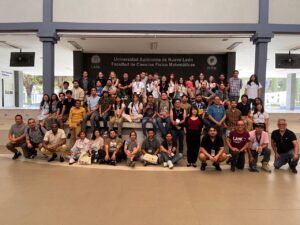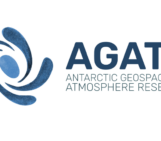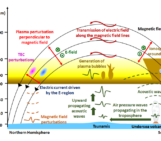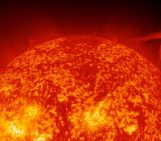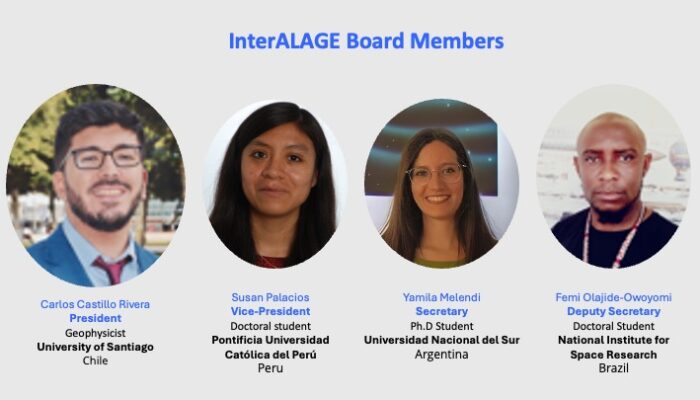
We are excited to introduce the InterALAGE Team! and share their vision for the future of the organization!
To get to know them better, our Media and Communications Officer conducted an in-depth interview with the new board members. In this engaging conversation, the board members share their personal backgrounds, journeys within InterALAGE, and goals during their term.
1. To start off, could you share a bit about your background and what you’re currently working on?
Carlos Castillo Rivera – President
Carlos is a Chilean geophysicist from the University of Concepción and holds a Master of Science in Physics from the University of Santiago, Chile. His main research interests lie in ionospheric studies. During his undergraduate thesis, he investigated traveling ionospheric disturbances (TIDs) induced by tsunamis. Currently, and throughout his master’s studies, he has been researching the effects of geomagnetic storms on the ionosphere at high latitudes.
Susan Palacios – Vice-President
Susan is currently pursuing a Doctorate in Computer Science at the Pontificia Universidad Católica del Perú (PUCP), where their research focuses on applying machine learning to the study of Equatorial Spread F (ESF)—a critical ionospheric phenomenon that disrupts satellite communications and GNSS accuracy, especially in equatorial regions. She has an academic background that blends electronic engineering and communication technologies, having completed a Bachelor’s degree at PUCP and a Master’s in Communication Technologies and Multimedia at the Università degli Studi di Brescia in Italy.
Yamila Melendi – Secretary
Yamila is a Geophysics graduate currently pursuing a Ph.D. in Physics at the Universidad Nacional del Sur (UNS) in Bahía Blanca, Argentina. She is also part of the Tucumán Space Weather Center and the secretary of InterALAGE. Her undergraduate thesis focused on geomagnetic storms, and her current research investigates the ionospheric response to space weather events.
Femi Olajide-Owoyomi – Deputy Secretary
Olajide-Owoyomi Femi is a doctoral student in Space Geophysics at the National Institute for Space Research (INPE) in São José dos Campos, Brazil. His current research focuses on the study of meteoric metal layers using a Sodium and Potassium dual-beam LIDAR system, contributing to a deeper understanding of upper atmospheric dynamics. Femi holds a Master’s degree in Space Physics and has a strong academic foundation in the geophysical sciences. His recent publications on this topic are available on his ResearchGate page.
2. We’d love to hear more about InterALAGE — could you tell us what it is, how it came about, and what areas of research it brings together?
InterALAGE is the Latin American student network for space geophysics. It was established in 2022 during the XIII Latin American Conference on Space Geophysics (COLAGE) in São José dos Campos, Brazil. InterALAGE is an organization of ALAGE (Latin American Association of Geophysics and Space Geophysics) and is fully supported by it.
InterALAGE aims to build a strong network among students interested in space geophysics by fostering connections, promoting awareness and enthusiasm for the field, and encouraging the participation of new students in diverse research areas. The initiative also serves as a hub for sharing information about training opportunities, including courses, conferences, and scholarships, empowering students to take an informed and proactive role in their academic and professional development.
In Latin America, we bring together students from various areas within space geophysics, including space plasma physics and nonlinear processes in space geophysics; solar physics, heliosphere, and cosmic rays; solar Wind and magnetosphere; the ionosphere and upper atmosphere; space weather monitoring and forecasting; and other related fields. Students who are part of the network conduct research across these topics.
3. For those in the scientific community who are interested, how can they get involved with InterALAGE? Are there specific ways to collaborate or contribute?
InterALAGE welcomes all Latin American students, whether at the undergraduate, Master’s, or PhD level, and including those studying or working abroad, to join a growing network dedicated to space geophysics. The main goal is to foster student connections and promote the exchange of opportunities, knowledge, and collaboration.
Throughout the year, we organize various activities including conferences, workshops, and collaborative workgroups, where students and researchers are invited to share their expertise and experiences. Members are encouraged to participate actively by attending events, giving talks, leading workshops, or contributing to the network’s growth through outreach and research initiatives.
Researchers, professors, and institutions are also encouraged to get involved by offering mentorship, sharing academic and professional opportunities, and supporting student development. We also welcome partnerships with organizations that share our mission of promoting space geophysics in Latin America.
Anyone interested can join the conversation through our official channels or follow us on social media to stay informed and connected. (https://alage.org/interalage/ , linktr.ee/interalage )
4. Looking ahead, what kinds of activities or initiatives are you envisioning for InterALAGE in 2025 and 2026? Any exciting plans or goals you’d like to share?
We organize two monthly virtual activities: the InterALAGE Conference Cycle, where researchers present recent findings in their fields, and the Young Scientists Cycle, where students share results from their own research. All talks are available on YouTube.
Last year, we also organized two virtual workshops led by students, each consisting of three classes: “From the Sun to the Earth (and beyond): Space Weather Modelling and Techniques” and “Cosmic Rays and Space Weather Analysis”.
In 2025 and 2026, we plan to continue with both talk cycles and offer new virtual workshops. A new activity we are planning is an informal English-speaking space where students can talk with a researcher, helping them practice their language skills for future conferences. In addition, we’ll be organizing practical sessions focused on academic development, including how to write scientific papers and how to prepare strong application letters for scholarships, internships, and graduate programs.
These efforts reflect our mission to promote academic and cultural development through student mobility and to foster collaboration and knowledge exchange among Latin American students in space geophysics. In 2026, we will also hold activities for Latin American students during the XV COLAGE and the International Space Science School.
5. Based on your experience organizing InterALAGE activities so far, what have been some of the highlights or challenges? Is there anything you wish you had known before getting started?
The main highlight is the commitment of the board members, country representatives, and workgroup leaders, who drive the activities of InterALAGE. It is also crucial to emphasize the high participation in our events and the motivation and interest of students in learning about space geophysics and connect with peers and more senior researchers.
One challenge we faced was coordinating meetings due to time zone differences. We have also learned the importance of clear communication and planning ahead to ensure inclusive participation.

